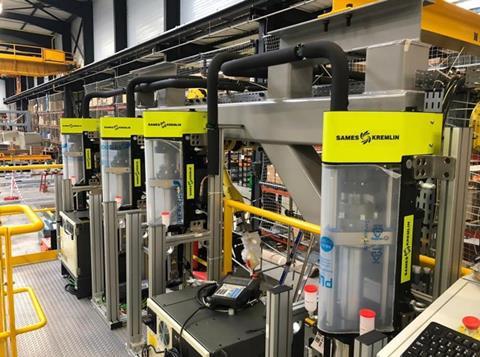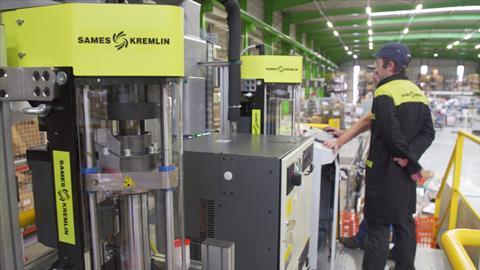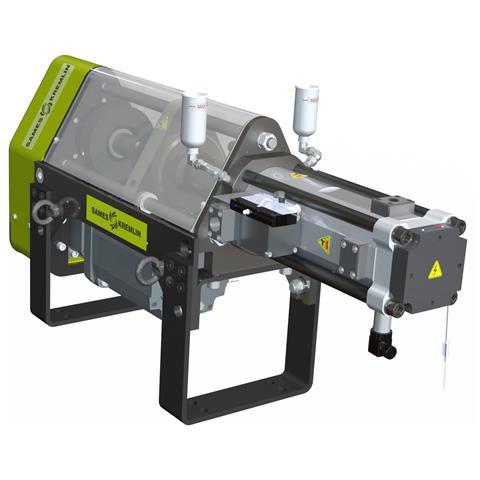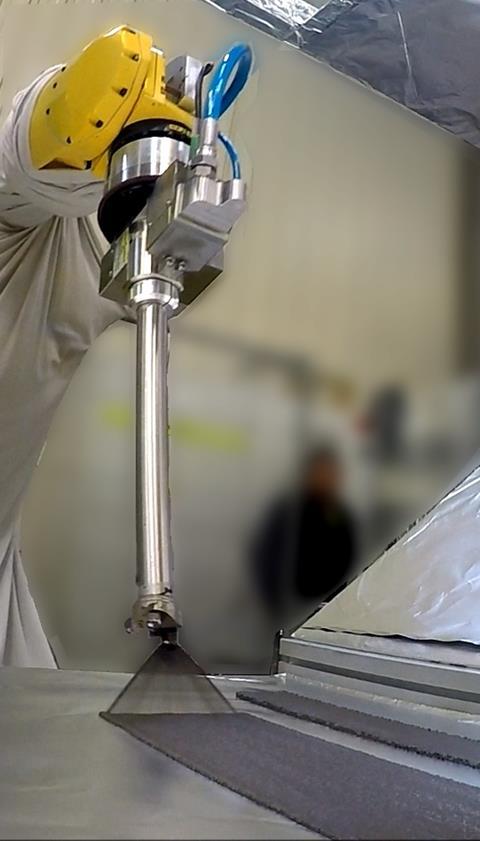OEMs are moving towards fully automated paintshop, and this will include robotic application of sealant and protecting solution to the car body. The application of sealant and sound deadener presents a challenge to balance lightweight and protection of the body. SAMES KREMLIN presents a solution for efficient dispensing with a high-performance applicator and dosing unit

Liquid sound deadener (LASD) is now replacing the traditional acoustic damping pads. This new material saves weight, reduces costs and stocks along the assembly line. Moreover, utilising a robot gives the flexibility to adapt the dispensed size and thickness of each application, according to the car model and reduce weight. The robotic process allows the pattern to be easily changed to increase the performance of dampening as needed.
Requests from OEMs to have a lower density and more environment friendly material, has seen the LASD manufacturers create a waterborne acrylic material. Achieving 50% of mass reduction compared to pads, this material is also compatible with the energy saving, lower bake temperatures now to used cure car bodies.
The challenge in using this new material relates to the pumping and dosing equipment because of its higher viscosity and abrasiveness. Using these wetted materials requires the pumps, regulators and shot meter chambers to be made of high grade of stainless steel, such as those made by SAMES KREMLIN.
The Nissan Sunderland paintshop is using the complete solution with two robotic booths to apply this kind of waterborne LASD on Qashqai bodies. Positioned upside-down, above the vehicle, all four robots enter the vehicle body through the window apertures to dispense LASD onto the floor pan. Each L1K dosing unit feeds one of the three nozzles of a 3D head manipulated by a robot.
For aluminium car bodies, the vibration modes are shifted to a high frequency (over 300Hz) compared to steel car bodies. The material manufacturers are adapting the chemicals, and the application process needs an accurate dosing process to deliver the most effective dampening performance, with the right thickness and position of the material on the plates.

Accurate dosing for material savings
The design of the L1K dosing unit follows these specifications for all types of accurate and high flow applications in paintshop sealing and sound deadener dispensing.
The electric shot meter is the most versatile and compact on the market; despite its large capacity of 1300cm3, the special chamber shape with First in/First out (FiFo) function can dispense only 10cm3 without any risk of remaining material inside. The external dimensions and the weight of the L1K are half that of competitor metering systems, and it can be fixed horizontally or vertically as required to save space in the paintshop.
With a maximum flow of 9L/min (150cm3/sec) and 250bar pressure, the dosing unit covers the complete range of applications in paintshop: under body sealing (UBS), under body coating (UBC), interior seam sealing (ISS), cosmetic seam sealing, liquid applied sound deadener (LASD).

Usually having a large volume dosing unit can be a disadvantage for accuracy, but the piston on this unit has a 300mm long stroke. Moreover, thanks to the 24-bit resolver on the motor, the controller has 16,000,000 values per turn, for only 0.57cm3. This makes the L1K is the most versatile tool for dispensing either a few cm3 or several hundreds of cm3 for all types of sealing applications.
For a fast process time, the filling of the dosing unit must be faster than the conveying time of car bodies to the dispensing booth. With 80bars of filling pressure, the complete refilling time is 10 seconds with the most viscous LASD tested, removing the need for expensive tandem dosing units.
A good application tool for a perfect result
To save time, a three headed applicator is also an asset. Each nozzle of the head aims in a different direction, which saves robot positioning time. This feature is particularly useful when the application robot is engaged inside a car body where there is limited movement of the first three axis of the robot, only the wrist being able turn. Having three oriented nozzles on the same applicator reduces the required rotations and can save up to 30% in the cycle time.
The 3D head saves time thanks to its long stem body for higher accessibility in narrow spaces, and its swivel and the rotation of nozzles made by the 6th axis of the robot wrist. Even after three turns, all hoses and cables connections remain on the robot arm avoiding any contact with the car body.
The high agility of the 3D head is due to it being lightweight, the rear positioning of its centre of gravity and having all needle actuators and connections at the rear end of the 300mm applicator. The weight is only 3.7kg at 115mm from the robot wrist, which allows increased application speed.
The final application results depend on the choice of nozzles. For LASD, we propose two types of nozzle: a flat stream variable width nozzle, or a large nozzle for flat stream constant angle. For sealing, we recommend flats stream nozzle, and hollow cone spray for under body coating, both nozzles have a constant angle, so the application distance is setting the width.

These choices have validated during the application trials at our sealing laboratories in Meylan, France, Shanghai, China, and Plymouth in the US.
In the 3D head, all three needles close the trigger just behind nozzle, so the material circulates during waiting time. Then the thixotropic material remains always ready for the trigger to be opened for the next application, removing the need to flush before each gun-on, which saves on material usage.
The dosing unit must perform reliably for long period and offer an extended service life, so the unit has an oversized roller screw featuring a hard chrome treatment and a triple linear guide with ball sleeves. We paid special attention to the sealing of the piston. This is made of Fluorotrel, an exceptionally high tear strength and low friction material, with the three energised seals inserted into a cartridge with lubrication to extend the service life.
By reducing the number of screws, and having common parts, the maintenance operations require the minimum of time (MTTR) and the design is robust for at least one year (MTBF). Also, having the same dosing unit for all sealing and sound deadener applications reduces the training investment and spare part costs for the paintshop.
To address requirements of IOT factories, the equipment is controlled with pressure and temperature sensors, so all data from the dispensing process is constantly available for data servers.
To get the best performance from this solution, we designed a unique twin loop regulation system, which allows it to adapt to any temperature change in the factory. Combining both the flow rate loop (at 5ms rate) and pressure ultra-fast loop (at 1ms rate), the software avoids the ‘fishtail’ effect due to the pressure drop at trigger-on, and the overshoot effect due to pressure overshoot during a trigger pause. The L1K can anticipate a boost in pressure before the gun opens and to reduce pressure after a trigger-off, to be at the correct pressure for next gun-on.
The result of all these technologies is a steady, constant and robust application for any type of sealing bead or ribbon of LASD.
Find out more here






































No comments yet